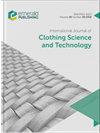Automatic generation of parametric patterns from grading patterns using artificial intelligence
IF 1
4区 工程技术
Q3 MATERIALS SCIENCE, TEXTILES
International Journal of Clothing Science and Technology
Pub Date : 2023-09-18
DOI:10.1108/ijcst-07-2022-0102
引用次数: 0
Abstract
Purpose This study aims to automate the process of converting grading patterns into parametric patterns using artificial intelligence and to objectively evaluate the fitness of the converted patterns. Design/methodology/approach The developed system consists of a user interface that defines input data by importing multi-size grading patterns, an artificial neural network that learns the relationship between human body size and pattern geometry, and a module that converts training results into parametric patterns. In order to evaluate the fitness of the generated pattern, an objective fitting evaluation method using drape simulation was developed. Findings The body sizes of the wearer were input to the converted parametric pattern to generate a customized pattern. Resulting pattern showed a better fit than the grading pattern on the off-average body model. Research limitations/implications In this study, a method has been developed that enables the users with minimal pattern drafting knowledge to convert grading patterns into parametric patterns using artificial intelligence and drape simulation. The human body's symmetry and the physical properties of fabric were not considered. Originality/value The system developed in this study requires less data compared to existing methods that attempt to design clothing patterns with machine learning. In addition, it was possible to evaluate pattern fitness on various body models through drape simulation based fit evaluation process for the first time.使用人工智能从分级模式自动生成参数模式
本研究旨在利用人工智能将分级模式自动转换为参数模式,并客观地评估转换模式的适应度。设计/方法/方法开发的系统包括一个用户界面,该界面通过导入多尺寸分级模式来定义输入数据,一个人工神经网络学习人体尺寸和模式几何之间的关系,以及一个将训练结果转换为参数模式的模块。为了对生成的图案进行适应度评价,提出了一种基于悬垂模拟的客观拟合评价方法。将佩戴者的身体尺寸输入到转换后的参数模式中,生成定制的模式。结果显示,与非平均体型模型上的分级模式相比,该模式具有更好的拟合性。在本研究中,开发了一种方法,使用户能够以最少的图案绘制知识,使用人工智能和褶皱模拟将分级图案转换为参数图案。没有考虑人体的对称性和织物的物理特性。与现有的试图用机器学习设计服装图案的方法相比,本研究中开发的系统需要更少的数据。此外,首次通过基于垂度模拟的适合度评价流程,对不同体型模型的模式适合度进行评价。
本文章由计算机程序翻译,如有差异,请以英文原文为准。
求助全文
约1分钟内获得全文
求助全文
来源期刊
CiteScore
2.40
自引率
8.30%
发文量
51
审稿时长
10 months
期刊介绍:
Addresses all aspects of the science and technology of clothing-objective measurement techniques, control of fibre and fabric, CAD systems, product testing, sewing, weaving and knitting, inspection systems, drape and finishing, etc. Academic and industrial research findings are published after a stringent review has taken place.

 求助内容:
求助内容: 应助结果提醒方式:
应助结果提醒方式:


